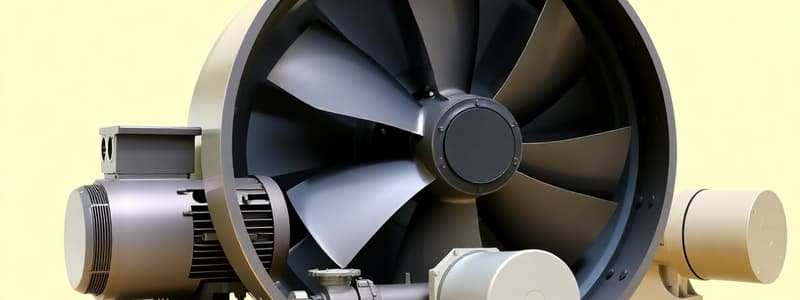Podcast
Questions and Answers
What energy savings can be achieved by right-sizing pumps?
What energy savings can be achieved by right-sizing pumps?
Right-sizing pumps can lead to energy savings of 20%.
What is one benefit of using larger pipes in pump systems?
What is one benefit of using larger pipes in pump systems?
Larger pipes can reduce frictional losses, potentially saving 15-20% in energy consumption.
How can connected pump systems contribute to energy savings?
How can connected pump systems contribute to energy savings?
Connected pump systems can be monitored and controlled remotely, optimizing operation based on real-time data.
What maintenance practice can help prevent energy losses in pumps?
What maintenance practice can help prevent energy losses in pumps?
What are indications that a pump may need to be replaced?
What are indications that a pump may need to be replaced?
What role do timers play in the operation of pumps and fans?
What role do timers play in the operation of pumps and fans?
What is the impact of oversized pumps on energy consumption?
What is the impact of oversized pumps on energy consumption?
How can isolating loops in a system improve energy efficiency?
How can isolating loops in a system improve energy efficiency?
What preventive measure can be taken to reduce energy losses in fan systems?
What preventive measure can be taken to reduce energy losses in fan systems?
How do centrifugal pumps function in residential and commercial applications?
How do centrifugal pumps function in residential and commercial applications?
What are the two main types of fans used in HVAC systems, and in what situations are they typically used?
What are the two main types of fans used in HVAC systems, and in what situations are they typically used?
What role do circulators play in hydronic heating systems?
What role do circulators play in hydronic heating systems?
What is the significance of Variable Speed Drives (VSDs) in pump energy consumption?
What is the significance of Variable Speed Drives (VSDs) in pump energy consumption?
In residential applications, which type of fan accounts for the largest share of energy consumption?
In residential applications, which type of fan accounts for the largest share of energy consumption?
What are two key energy-saving opportunities associated with pump motors?
What are two key energy-saving opportunities associated with pump motors?
How can upgrading to Brushless DC (BLDC) motors improve fan efficiency?
How can upgrading to Brushless DC (BLDC) motors improve fan efficiency?
Explain how Variable Speed Drives (VSDs) contribute to energy savings in fan systems.
Explain how Variable Speed Drives (VSDs) contribute to energy savings in fan systems.
How can hydraulic redesign contribute to energy savings in pump systems?
How can hydraulic redesign contribute to energy savings in pump systems?
What percentage of total residential energy consumption is accounted for by residential pumps?
What percentage of total residential energy consumption is accounted for by residential pumps?
What role does duct sealing play in enhancing overall fan system efficiency?
What role does duct sealing play in enhancing overall fan system efficiency?
In what applications are positive displacement pumps typically less common?
In what applications are positive displacement pumps typically less common?
Identify one energy-saving opportunity related to blade design in fan systems.
Identify one energy-saving opportunity related to blade design in fan systems.
What is the potential energy savings achieved by integrating occupancy sensors into fan systems?
What is the potential energy savings achieved by integrating occupancy sensors into fan systems?
Discuss the impact of right-sizing fans on energy efficiency.
Discuss the impact of right-sizing fans on energy efficiency.
Flashcards
Centrifugal Fans
Centrifugal Fans
Fans used in HVAC systems for high-pressure applications.
Axial Fans
Axial Fans
Fans suitable for high flow rates, commonly used in ventilation.
HVAC Fan Energy Consumption
HVAC Fan Energy Consumption
Residential HVAC fans account for 79% of total fan-related energy consumption
Brushless DC (BLDC) Motors
Brushless DC (BLDC) Motors
Signup and view all the flashcards
Variable Speed Drives (VSDs)
Variable Speed Drives (VSDs)
Signup and view all the flashcards
Backward-Inclined (BI) Blades
Backward-Inclined (BI) Blades
Signup and view all the flashcards
Duct Sealing
Duct Sealing
Signup and view all the flashcards
Occupancy Sensors
Occupancy Sensors
Signup and view all the flashcards
Centrifugal Pumps
Centrifugal Pumps
Signup and view all the flashcards
Positive Displacement Pumps
Positive Displacement Pumps
Signup and view all the flashcards
Hydronic Heating Circulators
Hydronic Heating Circulators
Signup and view all the flashcards
Variable Speed Drives (VSDs)
Variable Speed Drives (VSDs)
Signup and view all the flashcards
Residential Energy Consumption pumps
Residential Energy Consumption pumps
Signup and view all the flashcards
High-Efficiency Motors
High-Efficiency Motors
Signup and view all the flashcards
Hydraulic Redesign
Hydraulic Redesign
Signup and view all the flashcards
Commercial Energy Usage pumps
Commercial Energy Usage pumps
Signup and view all the flashcards
Pump Sizing
Pump Sizing
Signup and view all the flashcards
Optimized Piping
Optimized Piping
Signup and view all the flashcards
Preventative Maintenance
Preventative Maintenance
Signup and view all the flashcards
Connected Pump Systems
Connected Pump Systems
Signup and view all the flashcards
Demand Response
Demand Response
Signup and view all the flashcards
Pressure Switch Control
Pressure Switch Control
Signup and view all the flashcards
System Analysis
System Analysis
Signup and view all the flashcards
Replace Pump/Fan Strategy
Replace Pump/Fan Strategy
Signup and view all the flashcards
Study Notes
Energy Efficiency in Fans and Pumps
- Fans account for 79% of fan-related energy use in the residential sector.
- Circulation fans for furnaces are the largest single load in the residential sector.
- Fans account for 56% of total motor energy consumption in the commercial sector.
- Clean air ventilation fans are significant energy consumers in the commercial sector. Annual use exceeds 2 quads.
- Upgrading to brushless DC (BLDC) motors can enhance fan efficiency by 20-30%.
- Variable speed drives (VSDs) can reduce fan energy consumption by up to 40%.
- Advanced blade designs can boost fan efficiency by 15-30%.
- Backward-inclined blades improve fan efficiency significantly.
- Right-sizing fans can yield 5-20% energy savings.
- Sealing duct leaks reduces fan power consumption by 20-40%, improving system efficiency.
- Occupancy sensors can optimize airflow based on real-time demand, potentially saving 10-30% of fan energy.
- Regular maintenance enhances fan and pump efficiency.
Types of Fans
- Centrifugal fans are used in HVAC systems for high-pressure applications.
- Axial fans are suitable for high flow rates, commonly used in residential and commercial ventilation.
Applications of Fans
Residential Applications
- Central HVAC circulation fans.
- Ceiling fans for air circulation.
- Exhaust fans in kitchens and bathrooms.
- Window and through-the-wall air conditioners.
Commercial Applications
- Air handling units (AHUs) for ventilation.
- Exhaust fans for kitchens and industrial processes.
- Packaged terminal air conditioners (PTACS).
- Cooling tower fans for heat rejection.
Types of Pumps
- Centrifugal pumps are commonly used in residential and commercial applications. They convert kinetic energy from a spinning impeller to pressure.
- Positive displacement pumps are used for specific applications, but are less common in building systems due to higher costs and maintenance.
Residential Applications
- Hydronic heating circulators distribute heat in hot water boilers.
- Domestic water supply pumps are used for hot and cold water, including recirculation loops in larger homes.
- Pool pumps maintain water circulation and cleanliness.
Commercial Applications
- HVAC systems use pumps to circulate water for heating and cooling, including boilers and chillers.
- Potable water supply pumps are used in buildings without municipal connections, commonly in high-rise buildings.
- Industrial processes utilize pumps for cooling and heating systems.
Energy Consumption (Fans and Pumps)
- Residential pumps consume approximately 0.4 quads of primary energy annually, representing about 7% of total residential energy consumption.
- Commercial pumps use roughly 0.5 quads of primary energy, a significant portion of energy use in HVAC and water supply systems.
Energy Saving Opportunities (Fans)
- Installing variable speed drives (VSDs) can reduce energy consumption through demand-based operation, estimating potential annual savings of 0.1 quads for commercial applications.
- Upgrading to high-efficiency motors, with permanent magnet motors or ECMs, enhances efficiency by 10-20%.
- Hydraulic redesign of fans can improve performance, yielding 4% savings.
- Correct sizing of fans ensures efficient operation and results in 20% energy savings.
Energy Saving Opportunities (Pumps)
- Implementing variable speed drives (VSDs) lowers energy consumption from variable demands. An estimated commercial application annual saving is 0.1 quads.
- High-efficiency motors (permanent magnet motors or ECMs) deliver 10-20% efficiency improvement.
- Hydraulic redesign enhances pump performance by roughly 4%.
- Proper sizing provides 20% energy savings.
System Design and Maintenance (Fans and Pumps)
- Optimized piping configurations (larger pipes, advanced fittings) reduce frictional losses and potentially achieve 15-20% energy savings.
- Regularly scheduled maintenance prevents wear and tear, keeping performance at peak efficiency.
Smart Controls (Fans and Pumps)
- Integrating occupancy sensors optimizes airflow based on real-time demand, potentially saving 10-30% of energy.
- Integrating with building management systems enables real-time, remote monitoring and control for optimized operation.
- Educating users on optimal operation and maintenance strategies further enhances energy savings.
Common Places to Apply Efficiency
- Level control systems adjust pump operation only when necessary.
- Appropriate sizing prevents energy waste from oversized systems.
- Pressure switches allow systems to turn off when not needed.
- Elimination of unnecessary circulation loops reduces power consumption.
When to Replace a Pump or Fan
- Time wasted means energy wasted, so early replacement planning saves energy.
- Pump or fan failures, noise, vibration, heat, and deterioration signal replacement need.
- Correct sizing is vital, avoiding large fan/pump energy waste.
Ways to Reduce Maintenance Costs
- Switching off systems when not needed reduces operating costs.
- Employing timers and operational controls optimizes automatic activation and deactivation.
- Variable speed drives (VSDs) adjust motor speed to match task load demands, potentially saving up to 50% on operating costs.
- Regular maintenance schedules ensure consistent capacity and energy efficiency. Impeller changes improve efficiency. Assessing leaks, flow rate, and pressure are vital.
- Enhancing motor efficiency (a component of pumps and fans) results in better overall system function.
Studying That Suits You
Use AI to generate personalized quizzes and flashcards to suit your learning preferences.




